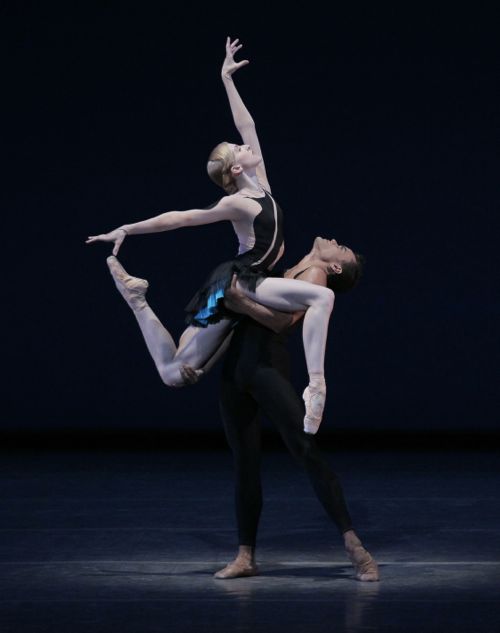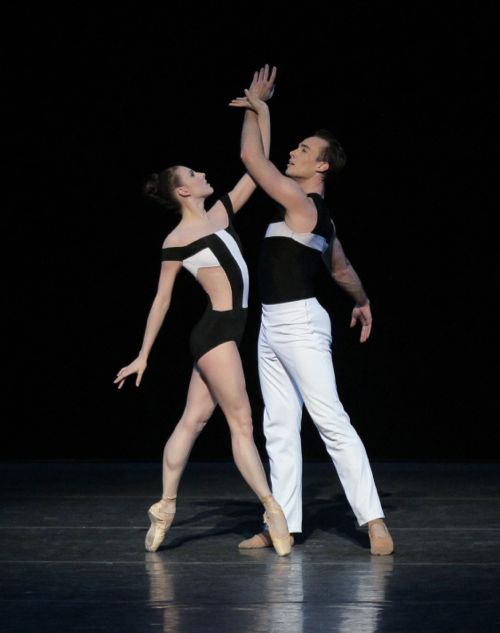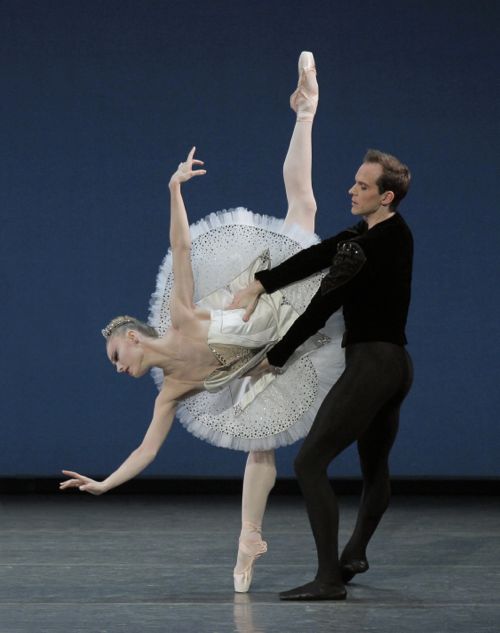New York City Ballet : Spring Gala, Á La Française / David H. Koch Theater, Lincoln Center, NYC / May 10, 2012
New York City Ballet’s spring gala treated its extravagantly dressed audience to two new ballets—one by Peter Martins, who heads the company, the other by the dancer and choreographer Benjamin Millepied, who recently retired from performing with the company and will be pursuing an ambitious project in Los Angeles. The evening was called Á La Française (in the French manner) and was duly decked out in French references—in the musical choices and, most pointedly, in the attempt at high-chic costumes.
 New York City Ballet’s Claire Kretzschmar and Taylor Stanley in Peter Martins’ Mes Oiseaux
New York City Ballet’s Claire Kretzschmar and Taylor Stanley in Peter Martins’ Mes Oiseaux
Photo: Paul Kolnik
Martin’s Mes Oiseaux (literally My Birds, make of this what you will), is set to a score for violin, cello, and piano by Marc-André Dalbavie that’s at once delicate, strong, and complex—like a spider web. The choreography, for a sole man and three women, can be understood as a Judgment of Paris affair (the mythical version, inflected by Antony Tudor’s ironic take), in which the gentleman must choose the “fairest” among three goddesses. In a process that’s too neatly organized and too long, Martins shows the fellow trying out each of the ladies, failing to arrive at a decision, and, of course, losing all three. The flighty trio goes off on its own—perhaps to set up a ménage á trois that has no need of him. Their identity lies in their togetherness more than it does in their individuality.
The three women’s dancing is immaculate. Lauren Lovette, Ashly Isaacs, and Claire Kretzschmar (whom I’d laid my bet on as the winner, from the way she rides the air)—looked capable of any challenge Martins set for them, no matter how esoteric. Everything they do is, presumably at Martins’ instruction, terrifyingly stripped of feeling.
Taylor Stanley, the Paris of this excursion, is not merely wonderful here, but unique in general. He has a muscular, sinewy quality, which can verge on the feral. This is rare in classical ballet, which assigns its most gifted men either to the noble prince or the virtuoso category. Tudor would have found a dramatic dancer in him. If Stanley were in a company like American Ballet Theatre, someone would already have created a latter-day Streetcar Named Desire to showcase him. At any rate, if ever there were a deeply three-dimensional dancer, it is he.
The costumes for the piece, by the fashion-world designer Gilles Mendel (supervised by Marc Happel, City Ballet’s director of costumes) clothe the trio of women in archly cut black tunics, each accented with a different sharp color. Stanley is given a less chichi equivalent, which you barely notice because of the deeply textured nature of his dancing. When, I wonder, will the dance world accept the fact that fashion designers, primarily intent on an immobile visual effect, are rarely a reliable choice for outfits subject to vigorous physical activity?
 Tiler Peck and Tyler Angle in Benjamin Millepied’s Two Hearts
Tiler Peck and Tyler Angle in Benjamin Millepied’s Two Hearts
Photo: Paul Kolnik
If the Martins ballet was disappointing, Millepied’s Two Hearts—set to a score by Nico Muhly, the choreographer’s favorite composer—was completely discouraging. Two terrific dancers, Tiler Peck and Tyler Angle, waste their time playing a couple that seems to suffer from fear of commitment (a prevalent postmodern malady). Or is it just a fear of sex? At any rate, embedded in an ensemble that’s a dozen strong, they seem to be working their way to a gratifying ending when the subject of the ballet shifts somehow into the threat of war, with the oversensitive couple making love before the man goes out to die.
If Millepied’s submerged stories remain chronically vague, his choreography is as inefficient as his hints at narrative. Any passage in it, no matter how small, seems not only disjunctive but improbable. It’s all one thing after another, with no relationship among the things. This inevitably puts musicality out of his reach, though Muhly’s scores are hardly dansant. The moves Millepied gives his dancers look arbitrary, constructions made for an absurdist human anatomy.
For the record, the costumes were equally hard on the eyes. Created by the sister designers of Rodarte, Kate & Laura Mulleavy, and “supervised by” Happel, they’re all uncompromising variations of jet black stripes on harsh white. When the full cast of 14 assembles and revs up the action, the designs might cause an epileptic seizure; even in repose, they’re jarring. After the two new ballets had been performed back to back, I was muttering Thoreau’s “Beware of all enterprises that require new clothes.”
 Sara Mearns and Jonathan Stafford in the second movement of Balanchine’s Symphony in C
Sara Mearns and Jonathan Stafford in the second movement of Balanchine’s Symphony in C
Photo: Paul Kolnik
Thankfully the final item on the program was a Balanchine masterwork, so coherence, musicality, and natural-looking invention were restored to the evening. The ballet was Symphony in C, set to the very dance-worthy Bizet score; it has finally been given new costumes. I don’t love the new Happel-designed ones, but at least they banished the folded dinner napkins that used to adorn the women’s tutus. The ballet, created in 1947 for the Paris Opera Ballet, was originally called Le Palais de Crystal (Crystal Palace) so it’s reasonable that now both the women’s white tutus and the men’s black velour tunics are thickly adorned with Swarovski crystals. The glitter is fun—somehow elegant and tacky at once, like a child’s fantasy of aristocratic elegance.
The ballet was well danced all through the ranks: principals, demi-soloists, and corps. Still the standout was Sara Mearns’ rendition of the second movement. In its own way, it ranks with the interpretations of Allegra Kent and Suzanne Farrell. Those two ballerinas, however, aimed for the sublime; Mearns doesn’t. She’s a specific woman, in our own place and time, fraught with the emotions of a life deeply—perhaps too deeply—experienced.
© 2012 Tobi Tobias



